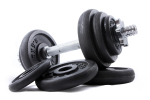|
2005/10/14, 10:32 PM
If you're ever wondering about the effects of all of the chemicals that are unknowingly forced on us, then this article/study I read is for you. It's not conclusive by any means, but it's a start!
Slew of pollutants found in babies
By Colleen Diskin
The Record (Hackensack N.J.)
HACKENSACK, N.J. - Mothers pass on hundreds of chemicals - from pesticides to flame retardants - to their babies through their umbilical cords, according to a groundbreaking study.
The study, released this month, found 287 industrial chemicals and pollutants in umbilical cord blood from 10 babies born in U.S. hospitals. The blood harbored pesticides, chemicals from non-stick cooking pans and plastic wrap, long-banned PCBs and wastes from burning coal, gasoline and garbage. On average, each baby had been exposed to 200 chemicals.
Scientists have long cautioned expectant mothers to limit their exposure to chemicals, by avoiding mercury-tainted fish, for example, and staying out of the nursery until the paint is dry. But the study, paid for by the Washington-based Environmental Working Group, is the first to examine the sheer number of exposures infants can have, via the umbilical cord, from pollutants that are nearly impossible for their mothers to avoid, the researchers said.
'Body burden'
It is the first to measure a baby's "body burden," the term used to describe the amount of pollutants buried in the bloodstream, organ tissues and fat cells.
Researchers and environmental advocates said the results are disconcerting.
"The numbers are startling when you hear them," said Dr. Alan Greene, a Stanford University pediatrician who wrote a commentary on the study.
In the month leading up to the baby's birth, the umbilical cord pumps at least 300 quarts of blood each day back and forth from the placenta to the fetus, bringing the baby oxygen and nutrients. Scientists once mistakenly thought the placenta shielded cord blood and the baby from most chemicals and pollutants.
Greene described the placenta as a "free-flowing, living lake" that the blood vessels in the umbilical cord draw from. "Today, this most primal of lakes has become polluted with industrial contaminants," Greene said. "And developing babies are nourished exclusively from this polluted pool. They mainline the contaminants through their umbilical cord, injecting them into their veins more potently than any IV drug administration."
The study raises more questions than it answers, in particular what the cumulative effect of all these chemicals might be on a newborn, said Tim Kropp, a senior scientist with the Environmental Working Group.
"For some of the chemicals, we know some safe levels for a single chemical in adults," Kropp said. "In none of them, however, do we know what the safe level is in combination with each other and not what it is in babies."
Although the sample of babies tested was small, one independent researcher credits the study with offering the first comprehensive look at what chemicals pass out of the placenta.
Michael Gochfield, a professor of environmental and occupational medicine at UMDNJ-Robert Wood Johnson Medical School, said he wouldn't be surprised if those results were found in most newborns. "There's always been a tremendous amount of suspicion, but no tests that have looked at this many chemicals," he said.
One reason there haven't been more studies is the cost of the tests: The Environmental Working Group paid $10,000 apiece to test the cord samples, Kropp said.
The samples were taken by the Red Cross for possible use in transplant operations. Rather than discarding the blood that can't be used, the Red Cross allows research organizations to have samples for approved studies.
The blood sample with the lowest readings contained 154 chemicals. The highest held 231.
Exposure to chemicals is a bigger concern with infants because the blood-brain barrier - the body's defense that keeps contaminants from reaching the central nervous system - is not yet developed, meaning babies can suffer more neurological harm, Greene said.
Future generations
In addition, female babies are born with the eggs that could become their own babies, meaning later generations will also be exposed, Greene said.
Greene and others affiliated with the study say it points to the need for a wider, publicly funded study of the impact of chemical exposure to children.
Although there are many chemicals to which expectant mothers and others cannot control their exposure - particularly those in the air and hidden inside furniture, computers and appliances - advocacy groups say there are ways consumers can reduce their body burdens.
Suggestions include eating locally grown food farmed without pesticides; not using chemicals on lawns; getting rid of bleaches, fabric softeners and cleaning products that contain colorants, fragrances and deodorizers; avoiding Teflon pans; and not using the microwave to heat foods in plastic containers that might leach chemicals.
"Some chemicals you can avoid by making personal choices," said Jane Nogacki, pesticide program organizer for the New Jersey Environmental Federation. "Others we need the government's help to get rid of."
|


